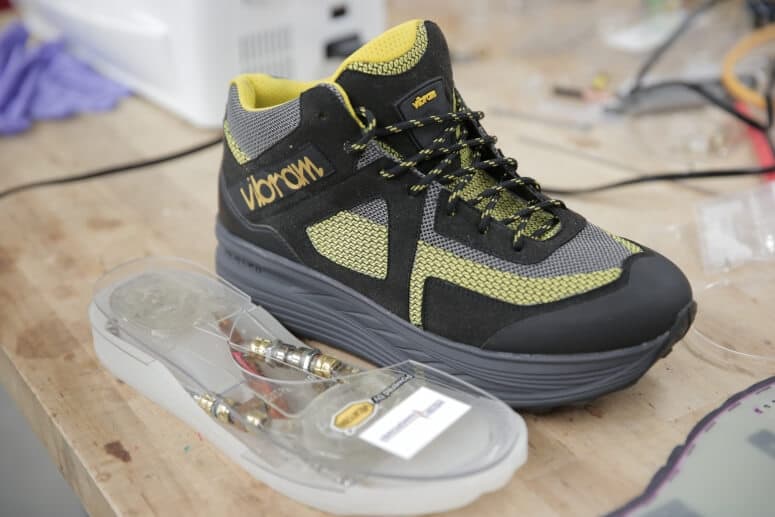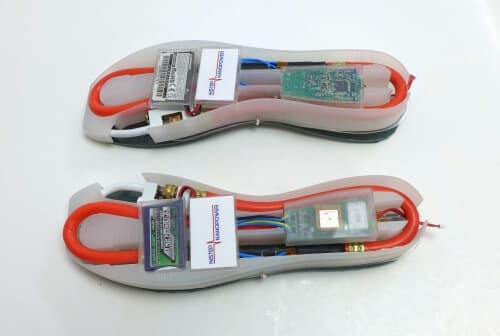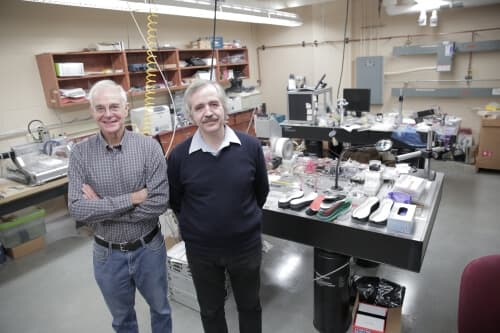Shoes That Let You Charge Smartphones As You Walk In Them
Engineers from University of Wisconsin–Madison have developed an unique energy harvesting and storage technology for capturing the energy of human motion to power mobile electronic devices. The energy generated while walking can be put to great use if captured and stored for later use, observe the researchers. Lead researchers J. Ashley Taylor and Tom Krupenkin made use of “reverse electrowetting†for developing the concept; a phenomenon which they pioneered in 2011. A conductive liquid interacts with a nanofilm-coated surface, and the mechanical energy is directly converted into electrical energy.

To overcome problems associated with drawing energy from various types of low-frequency energy sources, they developed a bubbler device — which contains no moving mechanical parts but two flat plates separated by a small gap filled with a conductive liquid. The bottom plate is covered with tiny holes through which pressurized gas forms bubbles. The bubbles grow until they’re large enough to touch the top plate, which causes the bubble to collapse. The speedy, repetitive growth and collapse of bubbles pushes the conductive fluid back and forth, generating electrical charge.
The bubbler truly works at optimum to produce high power densities, and has a promise to achieve by far the highest power density ever demonstrated, remark the researchers.

Upside-down shoe soles with an energy harvester, battery and electronics suite integrated into each sole. The harvester directly powers the electronics suite
The harvester could directly power various mobile devices through a charging cable, or it could be integrated with a broad range of electronic devices embedded in a shoe, such as a Wi-Fi hot spot. The latter requiring no cables, dramatically cuts the power requirements of wireless mobile devices, and can make a cellphone battery last 10 times longer between charges. Total drain of battery also stands to be reduced as energy cost of radio-frequency transmission back and forth between the phone and the tower is considered to be a tremendous contributor of drain.

J. Ashley Taylor (left) and Tom Krupenkin
The Power-generating shoes could prove to be very useful for the military, as soldiers currently carry heavy batteries to power their radios, GPS units and night-vision goggles in the field. The advance could also provide a source of power to people in remote areas and developing countries as India that lack adequate electrical power grids. The engineers are looking for industry to commercialise the technology through their startup company, InStep NanoPower.
The findings were published in the journal #-Link-Snipped-#
Source:<a href="https://news.wisc.edu/power-walk-footsteps-could-charge-mobile-electronics/" target="_blank" rel="nofollow noopener noreferrer">Power walk: Footsteps could charge mobile electronics</a>

To overcome problems associated with drawing energy from various types of low-frequency energy sources, they developed a bubbler device — which contains no moving mechanical parts but two flat plates separated by a small gap filled with a conductive liquid. The bottom plate is covered with tiny holes through which pressurized gas forms bubbles. The bubbles grow until they’re large enough to touch the top plate, which causes the bubble to collapse. The speedy, repetitive growth and collapse of bubbles pushes the conductive fluid back and forth, generating electrical charge.
The bubbler truly works at optimum to produce high power densities, and has a promise to achieve by far the highest power density ever demonstrated, remark the researchers.

Upside-down shoe soles with an energy harvester, battery and electronics suite integrated into each sole. The harvester directly powers the electronics suite

J. Ashley Taylor (left) and Tom Krupenkin
The findings were published in the journal #-Link-Snipped-#
Source:<a href="https://news.wisc.edu/power-walk-footsteps-could-charge-mobile-electronics/" target="_blank" rel="nofollow noopener noreferrer">Power walk: Footsteps could charge mobile electronics</a>
0

